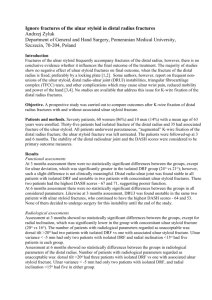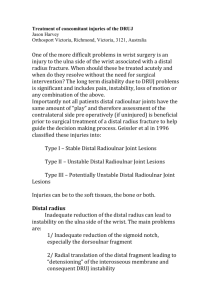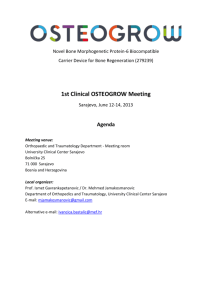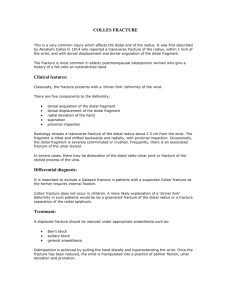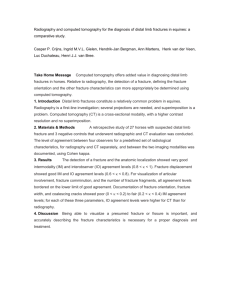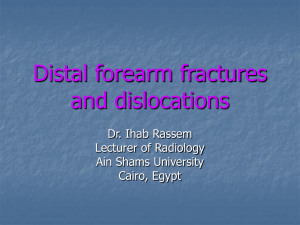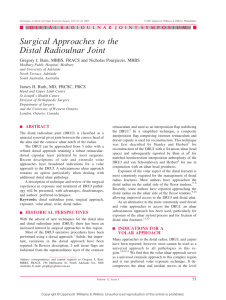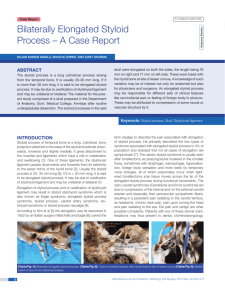1753-6561-9-S3-A43
advertisement
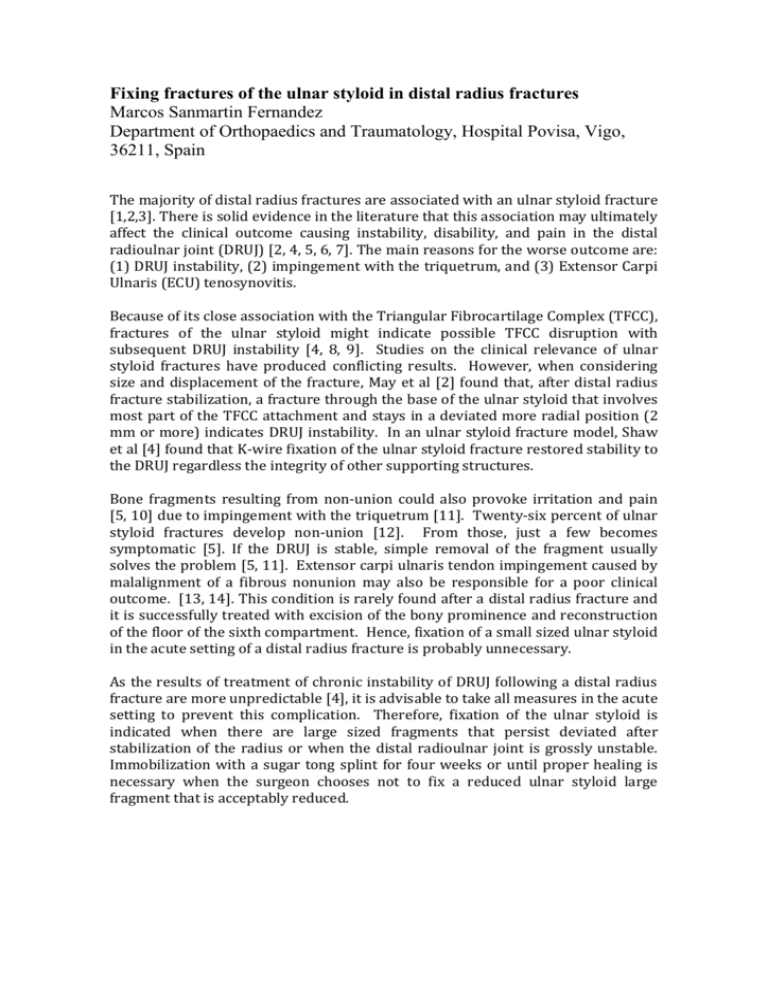
Fixing fractures of the ulnar styloid in distal radius fractures Marcos Sanmartin Fernandez Department of Orthopaedics and Traumatology, Hospital Povisa, Vigo, 36211, Spain The majority of distal radius fractures are associated with an ulnar styloid fracture [1,2,3]. There is solid evidence in the literature that this association may ultimately affect the clinical outcome causing instability, disability, and pain in the distal radioulnar joint (DRUJ) [2, 4, 5, 6, 7]. The main reasons for the worse outcome are: (1) DRUJ instability, (2) impingement with the triquetrum, and (3) Extensor Carpi Ulnaris (ECU) tenosynovitis. Because of its close association with the Triangular Fibrocartilage Complex (TFCC), fractures of the ulnar styloid might indicate possible TFCC disruption with subsequent DRUJ instability [4, 8, 9]. Studies on the clinical relevance of ulnar styloid fractures have produced conflicting results. However, when considering size and displacement of the fracture, May et al [2] found that, after distal radius fracture stabilization, a fracture through the base of the ulnar styloid that involves most part of the TFCC attachment and stays in a deviated more radial position (2 mm or more) indicates DRUJ instability. In an ulnar styloid fracture model, Shaw et al [4] found that K-wire fixation of the ulnar styloid fracture restored stability to the DRUJ regardless the integrity of other supporting structures. Bone fragments resulting from non-union could also provoke irritation and pain [5, 10] due to impingement with the triquetrum [11]. Twenty-six percent of ulnar styloid fractures develop non-union [12]. From those, just a few becomes symptomatic [5]. If the DRUJ is stable, simple removal of the fragment usually solves the problem [5, 11]. Extensor carpi ulnaris tendon impingement caused by malalignment of a fibrous nonunion may also be responsible for a poor clinical outcome. [13, 14]. This condition is rarely found after a distal radius fracture and it is successfully treated with excision of the bony prominence and reconstruction of the floor of the sixth compartment. Hence, fixation of a small sized ulnar styloid in the acute setting of a distal radius fracture is probably unnecessary. As the results of treatment of chronic instability of DRUJ following a distal radius fracture are more unpredictable [4], it is advisable to take all measures in the acute setting to prevent this complication. Therefore, fixation of the ulnar styloid is indicated when there are large sized fragments that persist deviated after stabilization of the radius or when the distal radioulnar joint is grossly unstable. Immobilization with a sugar tong splint for four weeks or until proper healing is necessary when the surgeon chooses not to fix a reduced ulnar styloid large fragment that is acceptably reduced. References 1. Frykman G. Fracture of the distal radius including sequela: shoulder-hand-finger syndrome, disturbance in the distal radioulnar joint and impairment of nerve function. Acta Orthop Scand (suppl.) 1967; 108: 1-153. 2. May MM, Lawton JN, Blazar PE. Ulnar styloid fractures associated with distal radius fractures: incidence and implications for distal radioulnar joint instability. J Hand Surg 2002; 27A: 965–71. 3. Villar RN, Marsh D, Rushton N, Greatorex RA. Three years after Colles’ fracture. A prospective review. J Bone Joint Surg 1987; 69B: 635–8. 4. Shaw JA, Bruno A, Paul EM. Ulnar styloid fixation in the treatment of posttraumatic instability of the radioulnar joint: a biomechanical study with clinical correlation. J Hand Surg 1990; 15A: 712– 20. 5. Hauck RM, Skahen J, 3rd, Palmer AK. Classification and treatment of ulnar styloid nonunion. J Hand Surg Am 1996; 21: 418–22. 6. Orhun H, Dursun M, Gürkan V, Sario E, Altun G, Akça O. A new index for the assessment of distal radius fractures involving the ulnar styloid. Acta Orthop Traumatol Turc 2011; 45(4): 261-5. 7. Krämer S, Meyer H, O’Loughlin PF, Vaske B, Krettek C. The incidence of ulnocarpal complaints after distal radial fracture in relation to the fracture of the ulnar styloid. J Hand Surg 2013; 38E(7): 710–7. 8. Af Ekenstam F, Jakobsson OP, Wadin K. Repair of the triangular ligament in Colles’ fracture: no effect in a prospective randomized study. Acta Orthop Scand 1989; 60: 393–6. 9. Lindau T, Arner M, Hagberg L. Intraarticular lesions in distal fractures of the radius in young adults. J Hand Surg 1997; 22B: 638-43. 10. Burgess RC, Watson HK. Hypertrophic ulnar styloid nonunions. Clin Orthop Relat Res 1988: 215–7. 11. Protopsaltis and Ruch, 2010 12. Bacorn RW, Kurtzke JE. Colles' fracture: a study of two thousand cases from the New York State Workmen's Compensation Board. J Bone Joint Surg 1953; 35A: 643-58. 13. Crimmins CA, Jones NF. Stenosing tenosynovitis of the extensor carpi ulnaris. Annals of Plastic Surgery 1995; 35: 105–7. 14. Kiyono Y, Nakatsuchi Y, Saitoh S. Ulnar–styloid nonunion and partial rupture of extensor carpi ulnaris tendon: two case reports and review of the literature. J Orthop Trauma 2002; 16: 674–7.

